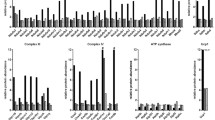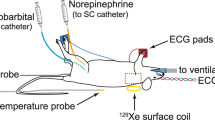Abstract
In eutherian mammals, uncoupling protein 1 (UCP1) mediated non-shivering thermogenesis from brown adipose tissue (BAT) provides a mechanism through which arousal from torpor and hibernation is facilitated. In order to directly assess the magnitude by which the presence or absence of UCP1 affects torpor patterns, rewarming and arousal rates within one species we compared fasting induced torpor in wildtype (UCP1+/+) and UCP1-ablated mice (UCP−/−). Torpor was induced by depriving mice of food for up to 48 h and by a reduction of ambient temperature (T a) from 30 to 18°C at four different time points after 18, 24, 30 and 36 h of food deprivation. In most cases, torpor bouts occurred within 20 min after the switch in ambient temperature (30–18°C). Torpor bouts expressed during the light phase lasted 3–6 h while significantly longer bouts (up to 16 h) were observed when mice entered torpor during the dark phase. The degree of hypometabolism (5–22 ml h−1) and hypothermia (19.5–26.7°C) was comparable in wildtype and UCP1-ablated mice, and both genotypes were able to regain normothermia. In contrast to wildtype mice, UCP1-ablated mice did not display multiple torpor bouts per day and their peak rewarming rates from torpor were reduced by 50% (UCP1+/+: 0.24 ± 0.08°C min−1; UCP1−/−: 0.12 ± 0.04°C min−1). UCP1-ablated mice therefore took significantly longer to rewarm from 25 to 32°C (39 vs. 70 min) and required 60% more energy for this process. Our results demonstrate the energetic benefit of functional BAT for rapid arousal from torpor. They also suggest that torpor entry and maintenance may be dependent on endogenous rhythms.





Similar content being viewed by others
Abbreviations
- BAT:
-
Brown adipose tissue
- CET:
-
Central European time
- NST:
-
Non-shivering thermogenesis
- UCP:
-
Uncoupling protein
- T a :
-
Ambient temperature
- T b :
-
Body temperature
References
Barclay RM, Lausen CL, Hollis L (2001) What’s hot and what’s not: defining torpor in free-ranging birds and mammals. Can J Zool 79:1885–1890
Braulke LJ, Heldmaier G (2010) Torpor and ultradian rhythms require an intact signalling of the sympathetic nervous system. Cryobiology 60:198–203
Brown JC, Staples JF (2010) Mitochondrial metabolism during fasting-induced daily torpor in mice. Biochim Biophys Acta 1797:476–486
Cannon B, Nedergaard J (2004) Brown adipose tissue: function and physiological significance. Physiol Rev 84:277–359
Dikic D, Heldmaier G, Meyer CW (2008) Induced torpor in different strains of laboratory mice. In: Lovegrove BG, McKechnie AE (eds) Hypometabolism in animals: torpor. hibernation and cryobiology. Pietermaritzburg, University of KwaZulu-Natal, pp 223–230
Ehrhardt N, Heldmaier G, Exner C (2005) Adaptive mechanisms during food restriction in Acomys russatus: the use of torpor for desert survival. J Comp Physiol [B] 175:193–200
Enerback S, Jacobsson A, Simpson EM, Guerra C, Yamashita H, Harper ME, Kozak LP (1997) Mice lacking mitochondrial uncoupling protein are cold-sensitive but not obese. Nature 387:90–94
Exner C, Hebebrand J, Remschmidt H, Wewetzer C, Ziegler A, Herpertz S, Schweiger U, Blum WF, Preibisch G, Heldmaier G, Klingenspor M (2000) Leptin suppresses semi-starvation induced hyperactivity in rats: implications for anorexia nervosa. Mol Psychiatry 5:476–481
Foster DO, Frydman ML (1978) Brown adipose tissue: the dominant site of nonshivering thermogenesis in the rat. Experientia Suppl 32:147–151
Gavrilova O, Leon LR, Marcus-Samuels B, Mason MM, Castle AL, Refetoff S, Vinson C, Reitman ML (1999) Torpor in mice is induced by both leptin-dependent and -independent mechanisms. Proc Natl Acad Sci USA 96:14623–14628
Geiser F (2004) Metabolic rate and body temperature reduction during hibernation and daily torpor. Annu Rev Physiol 66:239–274
Geiser F, Baudinette RV (1990) The relationship between body mass and rate of rewarming from hibernation and daily torpor in mammals. J Exp Biol 151:349–359
Golozoubova V, Cannon B, Nedergaard J (2006) UCP1 is essential for adaptive adrenergic nonshivering thermogenesis. Am J Physiol Endocrinol Metab 291:E350–E357
Granneman JG, Burnazi M, Zhu Z, Schwamb LA (2003) White adipose tissue contributes to UCP1-independent thermogenesis. Am J Physiol Endocrinol Metab 285:E1230–E1236
Hayward JS, Lisson PA (1991) Evolution of brown fat: its absence in marsupials and monotremes. Can J Zool 70:171–179
Heldmaier G (1970) Die Thermogenese der Mausohrfledermaus (Myotis myotis) beim Erwachen aus dem Winterschlaf. Z Vergl Physiol 63:59–84
Heldmaier G (1975) Metabolic and thermoregulatory responses to heat and cold in the Djungarian hamster, Phodopus sungorus. J Comp Physiol 102:115–122
Heldmaier G, Buchberger A (1985) Sources of heat during nonshivering thermogenesis in Djungarian hamsters: a dominant role of brown adipose tissue during cold adaptation. J Comp Physiol [B] 156:237–245
Heldmaier G, Ruf T (1992) Body temperature and metabolic rate during natural hypothermia in endotherms. J Comp Physiol [B] 162:696–706
Heldmaier G, Steinlechner S (1981) Seasonal control of energy requirements for thermoregulation in the Djungarian hamster (Phodopus sungorus), living in natural photoperiod. J Comp Physiol 142:429–437
Heldmaier G, Ortmann S, Elvert R (2004) Natural hypometabolism during hibernation and daily torpor in mammals. Respir Physiol Neurobiol 141:317–329
Hudson JW, Scott IM (1979) Daily torpor in the laboratory mouse, Mus musculus var. albino. Physiol Zool 52:205–218
Jansky L (1973) Non-shivering thermogenesis and its thermoregulatory significance. Biol Rev 48:85–132
Jastroch M, Withers KW, Taudien S, Frappell PB, Helwig M, Fromme T, Hirschberg V, Heldmaier G, McAllan BM, Firth BT, Burmester T, Platzer M, Klingenspor M (2008) Marsupial uncoupling protein 1 sheds light on the evolution of mammalian nonshivering thermogenesis. Physiol Genomics 32:161–169
Jethwa PH, I’anson H, Warner A, Prosser HM, Hastings MH, Maywood ES, Ebling FJ (2008) Loss of prokineticin receptor 2 signaling predisposes mice to torpor. Am J Physiol Regul Integr Comp Physiol 294:R1968–R1979
Lovegrove BG, Koertner G, Geiser F (1999) The energetic cost of arousal from torpor in the marsupial Sminthopsis macroura: benefits of summer ambient temperature cycles. J Comp Physiol [B] 169:11–18
Lyman CP, O’Brian RC (1986) Is brown fat necessary? In: Heller HC, Musacchia XJ, Wang LHC (eds) Living in the cold: physiological and biochemical adaptations. Elsevier, New York, pp 116–119
McKechnie AE, Lovegrove BG (2001) Heterothermic responses in the speckled mousebird (Colius striatus). J Comp Physiol [B] 171:507–518
McKechnie AE, Wolf BO (2004) The energetics of the rewarming phase of avian torpor. In: Barnes BM, Carey HV (eds) Life in the cold, evolution, mechanism, adaptation and application. Alaska University of Alaska Fairbanks, Institute of Arctic Biology, Fairbanks, pp 265–273
Mzilikazi N, Lovegrove BG, Ribeiro MO (2002) Exogenous passive heating during torpor arousal in free-ranging rock elephant shrews, Elephantulus myurus. Oecologia 133:307–314
Nicol SC, Morrow G, Andersen NA (2008) Hibernation in monotremes: a review. In: Lovegrove BG, McKechnie AE (eds) Hypometabolism in animals: hibernation, torpor and cryobiology. University of KwaZulu-Natal, Pietermaritzburg, pp 251–262
Nicol SC, Andersen NA, Arruda AP, Ruf T (2009) Rewarming rates of two large hibernators: comparison of a monotreme and a eutherian. J Therm Biol 34:155–159
Oelkrug R, Kutschke M, Meyer CW, Heldmaier G, Jastroch M (2010) Uncoupling protein 1 decreases superoxide production in brown adipose tissue mitochondria. J Biol Chem (PMID: 20466728)
Ootsuka Y, de Menezes RC, Zaretsky DV, Alimoradian A, Hunt J, Stefanidis A, Oldfield BJ, Blessing WW (2009) Brown adipose tissue thermogenesis heats brain and body as part of the brain-coordinated ultradian basic rest-activity cycle. Neuroscience 164:849–861
Ortmann S, Heldmaier G, Schmid J, Ganzhorn JU (1997) Spontaneous daily torpor in Malagasy mouse lemurs. Naturwissenschaften 84:28–32
Puchalski W, Bockler H, Heldmaier G, Langefeld M (1987) Organ blood flow and brown adipose tissue oxygen consumption during noradrenaline-induced nonshivering thermogenesis in the Djungarian hamster. J Exp Zool 242:263–271
Rowlatt U, Mrosovsky N, Englisch A (1971) A comparative survey of brown fat in the neck and axilla of mammals at birth. Biol Neonate 17:53–83
Ruby NF, Zucker I (1992) Daily torpor in the absence of the suprachiasmatic nucleus in Siberian hamsters. Am J Physiol 263:R353–R362
Scholander PF, Hock R, Walters V, Irving L (1950) Adaptation to cold in arctic and tropical mammals and birds in relation to body temperature insulation, and basal metabolic rate. Biol Bull 99:259–271
Shabalina IG, Hoeks J, Kramarova TV, Schrauwen P, Cannon B, Nedergaard J (2010) Cold tolerance of UCP1-ablated mice: A skeletal muscle mitochondria switch toward lipid oxidation with marked UCP3 up-regulation not associated with increased basal, fatty acid- or ROS-induced uncoupling or enhanced GDP effects. Biochim Biophys Acta 1797(6–7):968–980
Stone GN, Purvis A (1992) Warm-up rates during arousal from torpor in heterothermic mammals: physiological correlates and a comparison with heterothermic insects. J Comp Physiol [B] 162:284–295
Swoap SJ, Weinshenker D (2008) Norepinephrine controls both torpor initiation and emergence via distinct mechanisms in the mouse. PLoS One 3:e4038
Swoap SJ, Gutilla MJ, Liles LC, Smith RO, Weinshenker D (2006) The full expression of fasting-induced torpor requires beta 3-adrenergic receptor signalling. J Neurosci 26:241–245
Ukropec J, Anunciado RP, Ravussin Y, Hulver MW, Kozak LP (2006) UCP1-independent thermogenesis in white adipose tissue of cold-acclimated Ucp1−/− mice. J Biol Chem 281:31894–31908
Wang Y, Kimura K, Inokuma K, Saito M, Kontani Y, Kobayashi Y, Mori N, Yamashita H (2006) Potential contribution of vasoconstriction to suppression of heat loss and homeothermic regulation in UCP1-deficient mice. Pflugers Arch 452:363–369
Warnecke L, Geiser F (2010) The energetics of basking behaviour and torpor in a small marsupial exposed to simulated natural conditions. J Comp Physiol [B] 180:437–445
Webb GP, Jagot SA, Jakobson ME (1982) Fasting-induced torpor in Mus musculus and its implications in the use of murine models for human obesity. Comp Biochem Physiol 72A:211–219
Acknowledgments
This work was supported by DFG (grant #HE-990 to GH and CWM).
Author information
Authors and Affiliations
Corresponding author
Additional information
Communicated by H. V. Carey.
Rights and permissions
About this article
Cite this article
Oelkrug, R., Heldmaier, G. & Meyer, C.W. Torpor patterns, arousal rates, and temporal organization of torpor entry in wildtype and UCP1-ablated mice. J Comp Physiol B 181, 137–145 (2011). https://doi.org/10.1007/s00360-010-0503-9
Received:
Revised:
Accepted:
Published:
Issue Date:
DOI: https://doi.org/10.1007/s00360-010-0503-9




